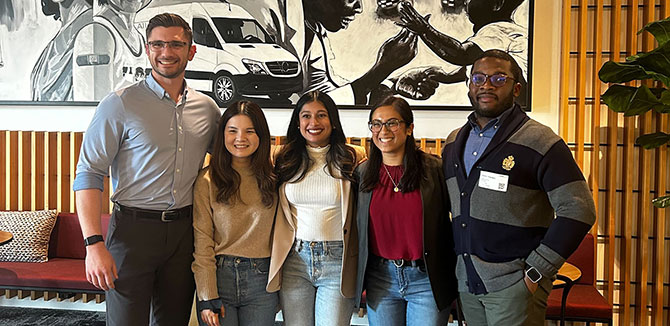Spotlighting Health and Wellness at Walgreens
Five students used Business Innovation Lab to apply lessons learned in Northwestern's MBA + MS Design Innovation (MMM) program to a real business problem facing Walgreens.

When Ebuka Nwaka emigrated from Nigeria to the United States, one of the first brands he became familiar with was Walgreens. So when Nwaka found out he'd be working with Walgreens for his final project in Northwestern's MBA + MS Design Innovation (MMM) program, he was beyond excited.
“I have fond memories from Walgreens, especially of their Nice!-brand chocolate cookies,” he said. “Working with Walgreens felt like giving back to a company that brought me simple joys through their products.”
Nwaka and four of his classmates collaborated with the retail and healthcare company as part of Business Innovations Lab (BIL), a two-quarter culmination of lessons learned during MMM — a dual-degree program between Northwestern Engineering and the Kellogg School of Management.
Nwaka, Rob De La Espriella, Preeya D'Mello, Christina Kappil, and Gwen Tran worked with Walgreens in improving its private label in order to increase value, loyalty, and product assortment to become a leading health and wellness destination for more customers.
Kappil, who called herself a loyal, life-long Walgreens customer, was also thrilled about the opportunity.
"I was excited to explore the retail and consumer aspects of healthcare through this partnership," said Kappil, who previously spent five years at medical equipment manufacturer Baxter. "People today are so much more attuned to their health, and I was curious to research how we could help them better achieve their health needs through Walgreens' offerings."
BIL is designed so students can apply lessons learned from their time in MMM to a real business challenge. The most notable of those lessons is human-centered design, where students perform in-depth customer research to guide the development of the most useful products and services.
Understanding Walgreens' customers proved to be one of the students’ biggest challenges.
"Customer purchasing patterns are complex, influenced by peers, family, experiences, price, packaging, prestige, and more," Nwaka said. "This complexity required us to engage in extensive group discussions to categorize and better understand these patterns."
Kappil agreed.
"Walgreens has such a large customer base with a variety of demographics and mindsets for shopping there," she said. "It was hard to narrow down on a particular customer profile to get insights from."
The team also learned what customers say and what they actually do can be different.
“Customer interviews are great, but you learn so much more from opportunities to go follow your research participants in real life,” Kappil said. “There are contexts you just don’t get to see unless you are in person.”
Kappil credited Research-Design-Build (RDB) and Mindful Product Management as pivotal courses that she relied on during BIL. RDB helped her see how customers think and organize concepts, while Mindful Product Management helped when it came to designing prototypes and testing key hypotheses.
For Nwaka, RDB and Equity Design Research exposed unconscious biases and enhanced his research approach with Walgreens customers.
None of the five team members had prior experience working in retail, so having the chance to apply lessons to a new field made for an even more valuable experience.
"What you learn in the classroom is pointless if you can’t apply it to the real world," Kappil said. "Human-centered design is a skill that needs to be practiced in real life. In the classroom everything is straightforward. In the real world we start to see there are complex barriers and internal constraints that may keep us from effectively executing on the design process. As we do more reps, we learn how to overcome those obstacles."
